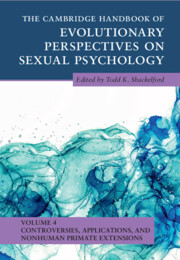Book contents
- The Cambridge Handbook of Evolutionary Perspectives on Sexual Psychology
- The Cambridge Handbook of Evolutionary Perspectives on Sexual Psychology
- Copyright page
- Contents
- Contributors
- Preface
- Part I Controversies and Unresolved Issues
- 1 The Female Sexual Orientation Spectrum in Evolutionary Perspective
- 2 The Evolution of Female Same-Sex Attraction
- 3 Male Bisexuality
- 4 Female Bisexuality
- 5 Masturbation in Primates
- Part II Applications to Health, Law, and Pornography
- Part III Nonhuman Primate Sexual Behavior
- Index
- References
5 - Masturbation in Primates
from Part I - Controversies and Unresolved Issues
Published online by Cambridge University Press: 30 June 2022
- The Cambridge Handbook of Evolutionary Perspectives on Sexual Psychology
- The Cambridge Handbook of Evolutionary Perspectives on Sexual Psychology
- Copyright page
- Contents
- Contributors
- Preface
- Part I Controversies and Unresolved Issues
- 1 The Female Sexual Orientation Spectrum in Evolutionary Perspective
- 2 The Evolution of Female Same-Sex Attraction
- 3 Male Bisexuality
- 4 Female Bisexuality
- 5 Masturbation in Primates
- Part II Applications to Health, Law, and Pornography
- Part III Nonhuman Primate Sexual Behavior
- Index
- References
Summary
Many vertebrate animals engage in masturbation and it is also prevalent in primates. Given the gregarious nature of this order, this is perhaps surprising, since, by definition, it occurs to the exclusion of others. Our research maps the masturbatory landscape of the primate order, highlighting the distribution and diverse forms self-stimulation of the genitalia takes: from an infant vervet monkey grasping his own penis in his mouth, to female chimpanzees using water spigots to stimulate their clitorises. We also examine the causation of this behavior. While autosexual behavior can be a substitute for allosexual interactions, many acts of masturbation seem to serve functions, which fall broadly under two categories: avoidance of pathogen transmission and reduction of mate competition. In terms of implications for human public health, the finding that masturbation is ubiquitous throughout the primate order, practiced by wild-living members of both sexes and all age-groups is a strong counter-argument to voices who condemn human masturbation as "unnatural."
- Type
- Chapter
- Information
- Publisher: Cambridge University PressPrint publication year: 2022



